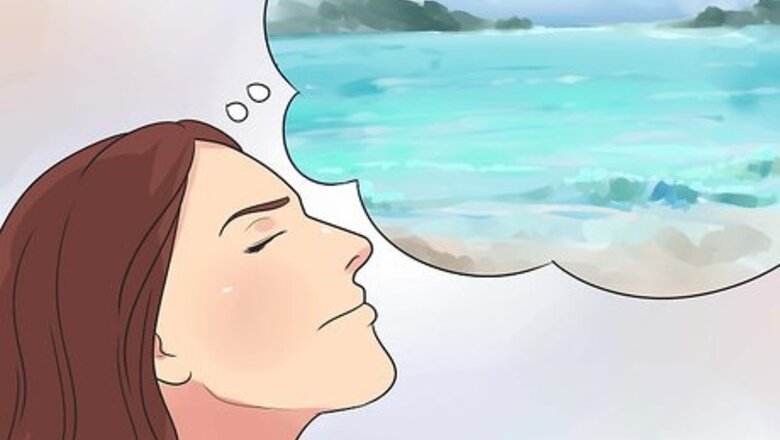
views
X
Research source
Control your stress.

Stress can be a debilitating condition associated with emotional and physical tension, and anxiety. In order to bring your fun-loving side up, try to reduce or eliminate stress in your life. Stress can result from both the negative (such as trouble at work or school) and positive (planning a friend's birthday party) events in your life. Nobody is a stranger to stress; however, if you experience stress long-term, it can negatively impact your health. Take steps to control stress and allow yourself to be more fun loving. Stress can be controlled by exercising regularly, resting and relaxing enough, eating a healthy diet, and treating yourself to something special.
Find an activity that makes you happy.

Try to find an activity that makes you happy and excited. This is especially important if you feel that you are not fun-loving because you never do anything that is fun or brings you joy. The activity that makes you happy can differ tremendously depending what type of person you are. Extroverts can find their happiness by seeking crowds and being in the center of attention, while introverts may find their energy in solitude. Whatever the activity, you need to figure it out yourself and then just do it. If you love the outdoors and enjoy nature, go hiking, skiing, running, swimming, or bicycling. These are easy-to-do activities that require little planning and equipment and you can easily do by yourself. Or try something new and go horseback riding, rock climbing, parasailing, backpacking, etc. You may surprise yourself and find an inner happiness you never knew existed. If you are the type that requires company and/or encouragement to try new things, ask your friend or spouse to come along. Finding a new hobby to do together can be a great way to bring your fun-loving side up too.
Engage in regular exercise.
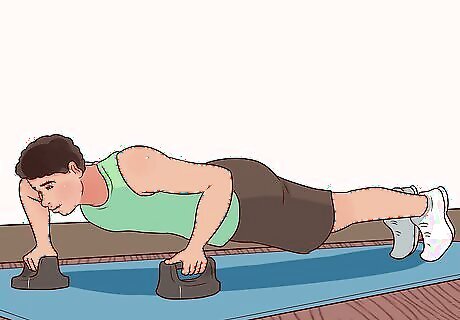
Exercise helps improve your overall health, makes you stronger, and makes your body work more efficiently. All these combined will make you more energetic. Choose exercise activities that you enjoy. Some people associate exercising with going to the gym or physical education class, but that is only a small fraction of what exercise can be. You can go walking, hiking, dancing, bicycling, or jogging, or you can play tennis, golf, racquetball, or some other sport. Not only will exercise improve your health and make you feel more energetic, it also helps you to become happier, more positive, and less anxious. Engage in some form of physical exercise at least 3-4 times or 150 minutes per week.
Eat a healthy diet.
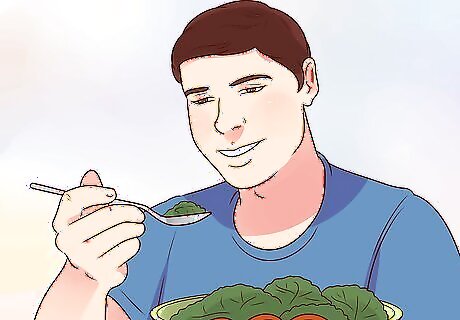
Our bodies need fuel for energy; that fuel is food. Build your diet around healthy, non-processed foods that provide all the necessary nutrients and help raise your energy levels. Avoid foods high in sugar and low in nutrition (called empty-calorie foods), such as pre-packaged meals, chips, sodas, and candy bars. These foods actually decrease energy levels after providing a very short energy boost. An ideal mix of ingredients to eat includes foods that provide complex carbohydrates, are low in fat, and contain moderate amounts of protein. Spread your daily calories evenly and avoid skipping a meal only to have a huge meal later. If possible, eat five meals a day, keeping the amount of calories in a day where you want. Do not skip any meals. This will cause a loss of energy. Your body needs food to keep going in the same way a vehicle needs gas to keep going. Also, drink plenty of water. Dehydration leads to low energy. Drink 8-9 glasses of water each day.
Drink caffeine in moderation.

Consuming caffeine can have a positive effect on your energy levels. In addition to boosting your mental and physical energy, caffeine also increases your fat oxidation and metabolic rate. Caution: caffeine is known to cause sleeplessness and jitteriness. The amount of caffeine you would need to consume to experience these effects differs from person to person and depends on your sensitivity to caffeine. The majority of healthy adults can safely consume caffeine in the amount of 400 milligrams (mg) a day.
Ensure you get all the necessary vitamins and minerals.
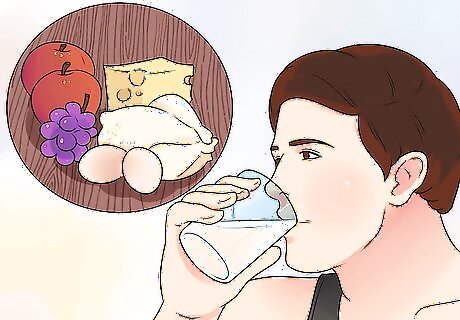
B vitamins and iron are important micronutrients that help support your energy levels. If you are deficient in these nutrients, you can experience lowered energy levels. B vitamins and iron are extremely important for your body’s ability to create and use energy. Vitamin 12, vitamin 6, thiamine, niacin, and folic acid support your body’s energy metabolism, while iron is needed for healthy red blood cells that are responsible for carrying oxygen. Deficiency in B vitamins and iron can lead to anemia and fatigue. If you are not getting enough of these and other micronutrients in your diet, consider taking a multivitamin with iron and essential B vitamins.
Get enough sleep.

If you suffer from a lack of energy, it might be because you are not getting enough sleep. According to the Sleep Foundation, adults should get between 7 and 9 hours of sleep each night. Make sure you get enough sleep. Set a regular bedtime and stick to it every night, even during the weekends. If you need to adjust your bedtime, make small daily increments (15 min earlier every night) until you achieve the target bedtime. Also, wake up at the same time every morning. Avoid heavy meals and too much alcohol just before bedtime as these might make sleeping more difficult. If you suffer from insomnia or sleep disturbances, it can lead to fatigue and a lack of motivation. However, fatigue can also be a sign of a more serious health condition. If you don't get energized by getting enough sleep and good nutrition, you should get evaluated by your doctor.
Practice yoga.

Practicing yoga can help reduce fatigue and boost your energy levels. It also offers other health benefits to your muscles and cardiovascular system. During yoga poses, breathe deeply to bring fresh oxygen to your blood. This will stimulate your nervous system and make you feel more energetic. Try the following breathing exercise: sit on the floor with your spine straight. Breathe in through your nose and count to four. Then exhale while counting to eight. Repeat. Try the Uttanasana yoga pose, which is an energizing forward bend: start by standing and bending forward and down. Keep your knees slightly bent and allow your upper body to hang toward the toes. Breathe deeply, while allowing your spine to lengthen.
Deal with sadness.

Like stress, sadness or feeling blue can also affect your emotional and physical well-being. It can also dampen your fun-loving side. If you are sad, you may also suffer from low enthusiasm, lethargy, and/or low self-esteem. If you are feeling low in energy, drive, and hope, it is more challenging to be fun-loving. Sometimes beating sadness can be as easy as leaving the house and diverting your sadness to something positive and fun. When you are feeling blue you might keep yourself isolated and avoid spending time with others. If you find yourself spending all your time alone at home, force yourself out of the house. You can go shopping, walking, or catch a funny movie at the theater. Anything that gets you out of the house and spending time with your friends and family will do. The hardest step is to leave the house, but once you do it and are out, you can often find yourself forgetting the sadness and enjoying life. If you cannot beat your sadness, consider seeking medical attention to determine if you may suffer from depression. Your doctor can prescribe antidepressants to treat depression. Seasonal depression is a common condition; an estimated 6.7% of the U.S. population suffered from at least one depressive episode in 2013. Caution: serious, untreated depression can lead to suicidal thoughts. If you or someone you know suffer from depression or a depressive episode, seek help immediately.
Learn to think more positively.

Negative thoughts and feelings have the capability to bring you down and lower your self-esteem. Learning to see the positive side in life can have a transforming effect and allow you to release your fun-loving side. You may not always be able to control your external environment, but you can control your inner thoughts. Even in tough situations, thinking positively can help you overcome barriers and release your fun-loving side. Seek situations that bring out the best in you and then learn to transfer that feeling to situations that might not bring out the best in you. This way you can learn to think positively even in situations that might normally bring out negative thoughts. Focus on what is good in your life and write it down on a piece of paper. Then carry that paper with you. When you find yourself down or unhappy, read through that list and try to change your negative thoughts to positive thoughts (e.g., the glass is half full, not half empty). You can also break free from negative thoughts by telling yourself “I can” and not allowing disrespectful people or bad situations to bring you down.
Honor and respect yourself.

Being able to be more fun-loving means you need to honor and love yourself first. Honoring yourself means honoring your life and what you have accomplished and created. This includes friendships, family, children, and even strangers that you have connected with. In order to honor yourself, you need to accept yourself for who you are. Only when you understand who you are and can embrace that person, can you bring your fun-loving side up. To learn to honor yourself, list your biggest achievements on a paper (e.g., graduated from school, had children, bought a house, climbed a mountain, achieved a personal goal, etc). Then, focus on those achievements and allow yourself to gain respect for yourself through them.
Break out of your comfort zone.

Sometimes being more fun-loving means you need to allow yourself to try new things. Often times we keep ourselves contained in a zone where we are comfortable, but that does not mean that is the place we are happiest. Allow yourself to try new things, take chances, and have fun. However, there are limitations to what you can and what you should do and you should never try or do things that cause harm to you or others. To break out, first understand your comfort zone and how you tend to stay in it naturally. Once you understand your comfort zone, change your normal way of thinking and acting and slowly break out of it. For example, start by making a list of all the things that you do to avoid uncertainty (e.g., are there situations that you avoid, do you check on your kids constantly, do you suffer from lack of trust). Once you have your list, start by picking the small items that you can do to break out of the cycle (e.g., go to a place you have never visited before, seek situations you normally avoid, allow yourself to be more trusting). Keep a record of all the times you succeeded in your goal and what happened (e.g., what happened when you visited a new place or pursued an unfamiliar situation).



















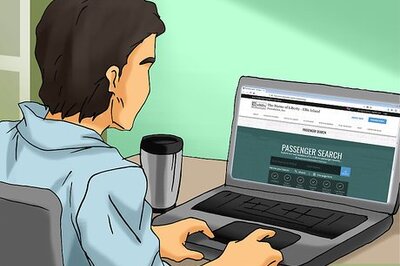
Comments
0 comment